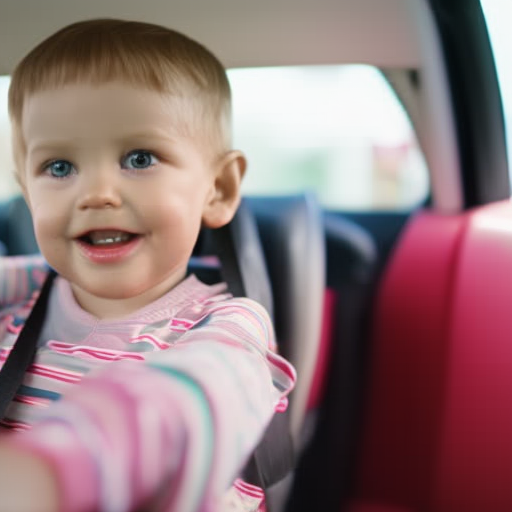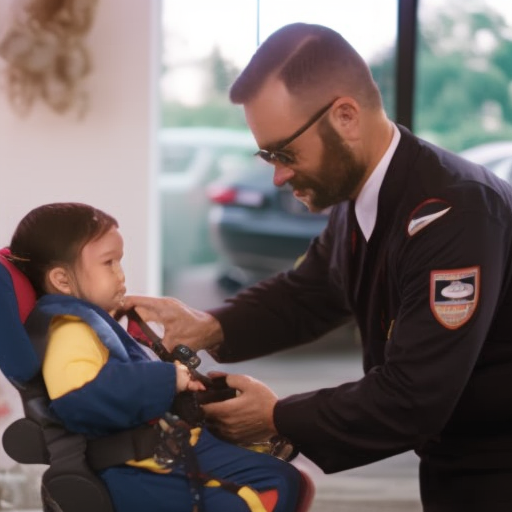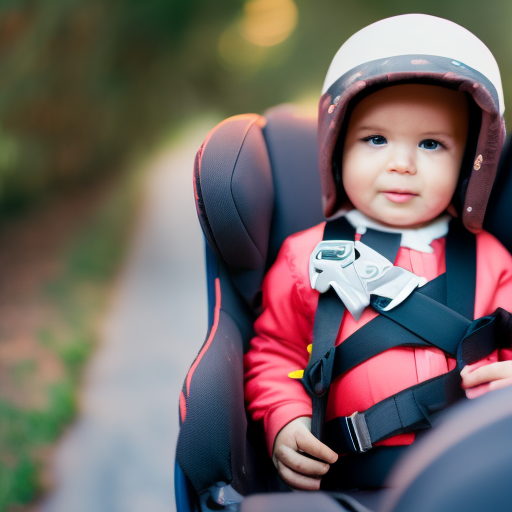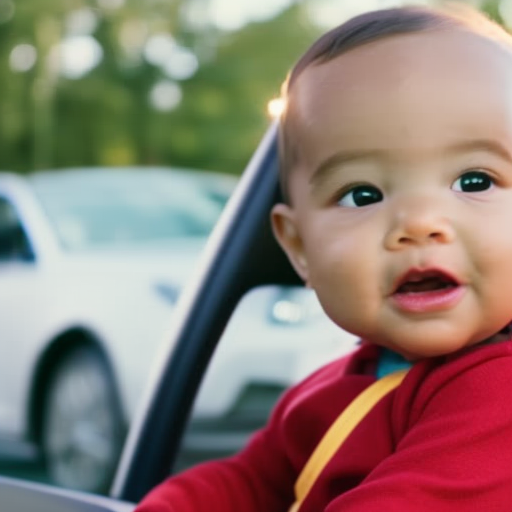"Cherishing Little Steps - A Haven for Baby and Family Journeys"
Car Seat Safety for Preschoolers
Are you confident that you’re keeping your preschooler safe in the car? When it comes to car seat safety, it’s essential to be well-informed.
In this guide, we will provide you with valuable information and practical tips to ensure your little one’s safety on the road. We’ll cover everything from age and weight guidelines to choosing the right car seat for your child.
We’ll also discuss the differences between rear-facing and forward-facing seats and provide safety tips for long car rides. Plus, we’ll address common struggles with car seats and share common mistakes to avoid.
By the end of this guide, you’ll have the knowledge and confidence you need to keep your preschooler safe during every car ride.
Key Takeaways
- Proper car seat installation is crucial for ensuring preschooler’s safety
- Understand age and weight guidelines for car seats
- Choose the right car seat appropriate for child’s age, height, and weight
- Rear-facing seats are safer than forward-facing seats, and children should remain in them until at least age two or specified limits
Importance of Car Seat Safety

Ensuring proper car seat safety is crucial for protecting your preschooler while on the road. Car seat installation and adherence to car seat regulations play a vital role in keeping your child safe during travel. It’s essential to understand the importance of these factors to ensure maximum protection for your little one.
First and foremost, correct car seat installation is key to ensuring your preschooler’s safety. Improper installation can significantly compromise the effectiveness of the car seat in the event of a collision. It’s crucial to carefully follow the manufacturer’s instructions and guidelines for installation, as well as consult your vehicle’s manual to determine the best location for the car seat.
Additionally, keeping up with car seat regulations is important for your child’s safety. Car seat regulations can vary by state and country, so staying informed and up to date is essential. This includes understanding the recommended age, weight, and height limits for each type of car seat, as well as knowing when to transition to the next stage of car seat.
Age and Weight Guidelines
To ensure your preschooler’s safety, it’s important to understand the age and weight guidelines for car seats. Following these guidelines will help you choose the right car seat for your child and ensure that they’re protected in case of an accident.
Age guidelines are important because they give you a general idea of when it’s safe to transition your child to a different type of car seat. For infants and toddlers, it’s recommended to use a rear-facing car seat until they’re at least two years old or until they reach the maximum height and weight limit of the seat. After that, you can switch to a forward-facing car seat with a harness.
Weight guidelines also play a crucial role in car seat safety. Different car seats have varying weight limits, so it’s important to choose one that can accommodate your child’s weight. For example, an infant car seat is designed to hold babies up to a certain weight, while a convertible car seat can adjust to accommodate both rear-facing and forward-facing positions and can hold children up to a higher weight limit.
Types of Car Seats

Choose the right car seat for your preschooler by understanding the different types available. Car seats are designed to keep your child safe and secure while traveling in a vehicle. There are three main types of car seats: rear-facing, forward-facing, and booster seats.
To help you make an informed decision, here is a table summarizing the different types of car seats and their recommended usage:
| Car Seat Type | Age Range | Weight Range |
|---|---|---|
| Rear-Facing | Birth to 2 years | Up to 35 pounds |
| Forward-Facing | 2 to 5 years | 22 to 65 pounds |
| Booster Seat | 4 to 12 years | 40 to 100 pounds |
It’s important to follow the car seat regulations set by your state and ensure proper installation. Here are a few installation tips to keep in mind:
- Read the car seat manual thoroughly before installation.
- Position the car seat in the back seat of your vehicle.
- Use the seat belt or LATCH system to secure the car seat.
- Ensure that the car seat is tightly secured and does not move more than an inch in any direction.
Choosing the Right Car Seat
What factors should you consider when selecting a car seat for your preschooler?
When choosing the right car seat, there are a few important factors to consider.
First, look for car seat brands that have a good reputation for safety and quality. Popular brands like Graco, Britax, and Chicco are known for their reliable and durable car seats.
It’s also crucial to check for safety certifications. Look for car seats that meet the standards set by the National Highway Traffic Safety Administration (NHTSA) and the Juvenile Products Manufacturers Association (JPMA). These certifications ensure that the car seat has undergone rigorous testing and meets safety regulations.
Additionally, consider the specific needs of your child. Look for car seats that are appropriate for their age, height, and weight. Some car seats are convertible and can be used from infancy to preschool age, while others are specifically designed for preschoolers.
Rear-Facing Vs. Forward-Facing Seats

Consider the benefits and safety recommendations of rear-facing and forward-facing car seats for your preschooler.
Rear-facing car seats provide numerous benefits for your child’s safety. In the event of a collision, they distribute the force of impact across the back of the car seat, reducing the risk of head, neck, and spine injuries. Additionally, rear-facing seats provide better support for your child’s underdeveloped head and neck muscles. The American Academy of Pediatrics (AAP) recommends that children remain in rear-facing car seats until at least the age of two or until they reach the height and weight limits specified by the car seat manufacturer.
On the other hand, forward-facing car seats pose certain risks. In the event of a collision, the force of impact is concentrated on the harness straps, potentially leading to injuries such as whiplash. The AAP recommends that children transition to forward-facing car seats only after they’ve outgrown the rear-facing height and weight limits. It’s important to note that the longer children remain in rear-facing car seats, the safer they are.
To ensure the utmost safety for your preschooler, it’s crucial to follow the recommendations of the AAP regarding car seat orientation. Rear-facing car seats offer significant benefits by providing better protection for your child’s head, neck, and spine. Transitioning to forward-facing car seats should only occur once the child has outgrown the rear-facing height and weight limits. By adhering to these guidelines, you can help keep your preschooler safe and secure while traveling.
Proper Installation Techniques

To ensure the utmost safety for your preschooler, it’s essential to properly install their car seat. Proper installation techniques can help alleviate car seat struggles and give you peace of mind while driving.
Here are three key tips to help you install your child’s car seat correctly:
-
Read the car seat manual: Each car seat has specific installation instructions. Take the time to carefully read and understand the manual provided by the manufacturer. It will guide you on how to secure the seat and adjust the harness properly.
-
Use the right installation method: There are different installation methods, including the LATCH system and the seat belt installation. Make sure you understand which method is recommended for your car seat model and your vehicle. Follow the instructions to ensure a secure and tight fit.
-
Seek professional help if needed: If you’re unsure about the installation or are facing difficulties, don’t hesitate to seek assistance from a certified car seat technician. They can provide expert guidance and ensure that the car seat is installed correctly.
Harnessing and Buckling Up

After properly installing your preschooler’s car seat, securing the harness and buckling up is the next crucial step in ensuring their safety during travel. Proper positioning of the harness is essential to provide maximum protection for your child.
Start by making sure that the harness straps are at or just above your child’s shoulders. Adjust the straps so they fit snugly against your child’s body, but not too tight that it restricts their movement or causes discomfort.
Next, secure the latch of the harness. This is an important step that shouldn’t be overlooked. The latch should be buckled securely and snugly, with no slack or looseness. You can test the tightness by pinching the harness strap at your child’s shoulder. If you can pinch any excess strap, it means that the harness is too loose and needs to be tightened.
Remember to check the harness and buckle regularly to ensure they remain secure throughout the journey. It’s also important to teach your child the importance of staying buckled up and not trying to unbuckle themselves during the ride.
Adjusting Straps and Harnesses
Make sure to properly adjust the straps and harnesses of your preschooler’s car seat for optimal safety. Here are three key steps to ensure a proper fit:
-
Position the chest clip at armpit level: The chest clip should be positioned at your child’s armpit level to keep the straps in the correct position. This helps distribute crash forces evenly across the chest and shoulders, reducing the risk of injury.
-
Check for a snug fit: The straps should be snug, with no slack. You shouldn’t be able to pinch any excess fabric between your fingers. A snug fit ensures that your child is secure and minimizes the risk of them slipping out in the event of a crash.
-
Ensure correct shoulder strap placement: The shoulder straps should be threaded through the slots at or just above your child’s shoulders. If the straps are too low, they can slip off during a crash. If they’re too high, they can cause discomfort and restrict your child’s movement.
Safety Tips for Long Car Rides
Now, let’s focus on how you can ensure a safe and comfortable journey for your preschooler during long car rides.
Long car rides with preschoolers can be challenging, but with a little preparation, you can make the experience enjoyable for both you and your child. Here are some tips to keep in mind:
Firstly, it’s important to plan ahead and pack some activities to keep your preschooler entertained. Bring along their favorite books, toys, or coloring books to keep them engaged during the journey. You can also play interactive games like ‘I Spy’ or sing along to their favorite songs.
Secondly, managing bathroom breaks is crucial during long car rides. Make sure to schedule regular bathroom breaks to avoid any discomfort or accidents. Plan your stops in advance by identifying rest areas or gas stations along your route. Encourage your child to use the bathroom during these breaks, even if they say they don’t need to go.
Lastly, ensure your child’s comfort by dressing them in comfortable clothing and providing them with a cozy blanket or pillow. Adjust the temperature in the car to suit their needs and consider using sunshades to protect them from direct sunlight.
Dealing With Car Seat Struggles

To address car seat struggles, ensure that you properly install the car seat and secure your preschooler using the appropriate harness system. This will help keep your child safe and minimize any potential issues.
However, even with the correct installation and harness system, dealing with tantrums and transitioning to a booster seat can still pose challenges. Here are some tips to help you navigate these situations:
-
Stay calm: It can be frustrating when your child throws a tantrum during car rides, but it’s important to stay calm and composed. Losing your temper can escalate the situation and make things worse. Take a deep breath and remember that your child’s safety comes first.
-
Communicate: Talk to your preschooler and explain the importance of using a car seat. Help them understand that it’s for their safety and that everyone in the car needs to be buckled up. Use simple language and be patient in your explanations.
-
Gradual transition: When it’s time to transition to a booster seat, do it gradually. Start by using the booster seat for short trips and gradually increase the duration. This will help your child get used to the new seat and feel more comfortable.
Common Mistakes to Avoid

To ensure the safety of your preschooler in a car seat, it’s important to avoid common mistakes.
One common mistake isn’t properly installing the car seat. It’s crucial to follow the manufacturer’s instructions and use the seat belt or LATCH system correctly. Double-check that the seat is securely fastened and doesn’t move more than an inch side to side or front to back.
Another common mistake is transitioning your child to a booster seat too soon. Preschoolers should remain in a forward-facing car seat with a harness until they reach the maximum weight or height limit specified by the car seat manufacturer.
Using the car seat incorrectly is also a common error. Ensure that the harness straps are snug and positioned at or slightly above your child’s shoulders. The chest clip should be at armpit level. Additionally, avoid placing bulky clothing or blankets under the harness, as this can decrease the effectiveness of the straps.
Resources for Car Seat Safety Information

You can find helpful resources for car seat safety information by consulting reliable sources such as government websites and certified child passenger safety technicians.
Here are three recommended car seat safety resources:
-
National Highway Traffic Safety Administration (NHTSA): The NHTSA is a government agency that provides comprehensive information on car seat safety guidelines. Their website offers detailed guides on choosing the right car seat, installing it correctly, and ensuring proper usage. You can also find information about recalls and safety ratings for different car seat models.
-
American Academy of Pediatrics (AAP): The AAP is a trusted organization that focuses on the health and safety of children. They offer valuable resources on car seat safety, including guidelines for choosing the right seat based on your child’s age and size, as well as tips for proper installation and usage. Their website also provides information on the latest research and recommendations.
-
Certified Child Passenger Safety Technicians (CPSTs): CPSTs are professionals trained to provide expert advice on car seat safety. They can help you with proper installation, answer any questions you may have, and ensure that your child’s car seat is correctly fitted. You can find CPSTs in your area by visiting the NHTSA website or contacting your local fire department or police station.
Frequently Asked Questions
How Do I Know if My Car Seat Is Installed Correctly?
You can tell if your car seat is installed correctly by checking for common mistakes like loose straps or improper angle. Follow car seat installation tips to ensure your child’s safety.
What Should I Do if My Child Outgrows Their Car Seat Before They Are Ready to Move to the Next Stage?
If your child outgrows their car seat before they’re ready for the next stage, there are alternative options available. One option is to use extension straps to provide a secure fit and keep them safe.
Can I Use a Second-Hand Car Seat for My Preschooler?
Yes, you can use a second-hand car seat for your preschooler, but it’s safer to buy a new one. Make sure it has a base and meets all safety regulations to protect your child.
How Often Should I Replace My Preschooler’s Car Seat?
When is it time to upgrade your preschooler’s car seat? The most common mistakes parents make when installing car seats are not properly securing them and using expired seats. Avoid these errors for your child’s safety.
Are There Any Additional Safety Measures I Should Take When Traveling With Multiple Preschoolers in the Car?
When traveling with multiple preschoolers in the car, ensuring their safety is crucial. Use a separate car seat for each child to avoid compromising their safety. Consider car seats with higher weight and height limits for a proper fit.
Conclusion
Now that you understand the importance of car seat safety for preschoolers, remember this:
A car seat is like a protective cocoon for your child during car rides. Just like a caterpillar transforms into a beautiful butterfly within its cocoon, your child is safe and secure in their car seat, ready to explore the world around them.
By following the guidelines, choosing the right seat, and avoiding common mistakes, you can ensure your child’s safety and peace of mind on every journey.


